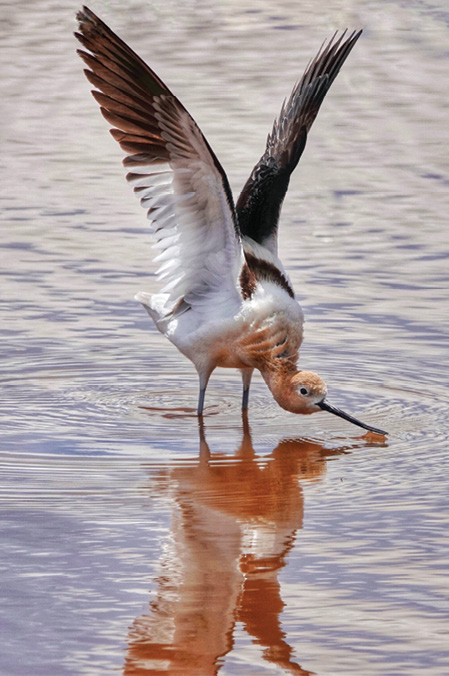Birdwatching
TAKES FLIGHT
Written by Damian Fagan
Short-eared owl in flight at Malheur National Wildlife Refuge, photo: Lane Wintermute
If you are new to birdwatching, you are in for a real tweet. Birding is an entertaining and fascinating year-round activity that involves observing birds in various areas whether a backyard, a nearby park or a state or federal wildlife refuge. Birds ignite interest with colorful patterns, migration feats, aerial acrobatics and sweet songs. Interest in birding is shared by more than 96 million Americans who, according to the 2022 Survey of Fishing, Hunting, and Wildlife-Associated Recreation conducted by the U.S. Fish and Wildlife Service, engaged in birdwatching at or near their homes and by 42 million people who traveled to observe wild birds.
Getting started
To start birding, a good set of binoculars (“bins” in birderspeak) will aid in viewing these avian creatures, and a field guide, such as David Sibley’s The Sibley Guide to Birds of Western North America, will help
with identification.
“During my 50 years of being an outdoor writer, I have seen birdwatching grow from an eccentric activity of a few to a major outdoors recreation,” said Pete Zimowsky, outdoor writer for the Idaho Press and long-time outdoor editor for the Idaho Statesman.
Another tip for novice birders is to join a local birding group for a field trip. “Going on a birding trip allows you to experience the incredible diversity of birds away from home—and oftentimes, these trips offer other kinds of wildlife watching, natural history and cultural experiences leaving you with a new appreciation of a place,” said Tara Lemezis, Bird Alliance of Oregon’s assistant director of adult learning and engagement. Birders are usually more than willing to take newbies under their wing and help them learn how to identify birds.
If you enjoy making lists, you may have birding DNA. Many birders keep lists, ones for yard, county or state birds spotted, along with lifelong inventories and even lists of birds seen while on walks. The free eBird app, a Cornell Lab of Ornithology project, is a way to record your bird sightings and search for hotspots. The lab also developed the free Merlin Bird ID app, which uses AI technology to guide observers step by step, based on their region to answer the question, “What’s that bird?” Once ready to explore, visit one or more of these prime locations throughout the West.
Birding Idaho
Kootenai National Wildlife Refuge, photo: Visit Idaho

The Peregrine Fund’s World Center for Birds of Prey. Photo: Visit Idaho
The Camas National Wildlife Refuge, located 12 miles north of Sage Junction along Interstate 15, consists of ponds, marshes, sagebrush uplands, meadows and farm fields within the approximately 11,000-acre refuge. More than 300 species of birds have been recorded since the the refuge was established in 1937. Depending on how much time you have, take a short (3.5-mile) or longer (7-mile) auto tour through the refuge to view waterfowl, eagles and songbirds.
In the northern panhandle, the Kootenai National Wildlife Refuge, located six miles east of Bonners Ferry, is nestled in a lush valley surrounded by the Selkirk, Cabinet and Purcell mountains. A great birding location for waterfowl and songbirds, more than 220 species of birds have been recorded within the 2,774-acre refuge. A 4.5-mile-long auto tour loops around the refuge. Besides birds, there are moose, bear, elk and river otters in the refuge.
Bonus Spot: The Peregrine Fund’s World Center for Birds of Prey in Boise offers educational programs and numerous live raptors to view.
Birding Oregon
Watch birds at the Upper Klamath Basin, photo: courtesy of Discover klamath/Larry Turner

American avocet, Malheur National Wildlife Refuge. Photo: Linda Klein
In southeastern Oregon, the Malheur National Wildlife Refuge, found 30 miles south of Burns, encompasses more than 187,000 acres and was designated as an Important Bird Area in Oregon. Established in 1908 by President Theodore Roosevelt, the refuge protects this habitat for thousands of migratory and nesting birds along the Pacific Flyway.
Sandhill cranes, American white pelicans, burrowing owls and bobolinks, a bird that migrates from South America to breed in the northern U.S. and southern Canada, may be viewed from the 42-mile-long self-guided auto tour (known as the Central Patrol Road), which traverses lengthwise through the preserve. Near the refuge’s southern end is the historic Frenchglen Hotel run by an Oregon State Parks concessionaire, which serves family-style meals, has overnight accommodations and good birding in the yard.
The entire Oregon Coast—from Astoria to Brookings–is a highly recommended birding area. Numerous public-accessible beaches and headlands offer ocean views for common murres, cormorants, tufted puffins and brown pelicans. Fort Stevens State Park near Astoria, the Yaquina Head Outstanding Natural Area in Newport and Harris Beach State Park in Brookings are some of the many spots to bird (and whale watch) along the coast.
Bonus Spot: The Oregon Coast Aquarium in Newport has an aviary to view seabirds up close.
Though birding is a mild- mannered activity, it can lead to behaviors such as “twitching” (chasing rarities) or calling in sick because of a migration fallout. You might start talking about “LBJs” (Little Brown Jobs, often some type of sparrow), “phishing” (subtle sound to draw birds out of hiding), and “lifers” (new birds added to your life list). Consider yourself warned and happy birding.
Founded in 1981, nonprofit Oregon Wildlife Foundation supports the conservation of Oregon’s fish, wildlife and natural resources. See myowf.org.
The Idaho Fish and Game Department’s Idaho Birding Trail guide, available online or in print, is a resource for birding sites and viewing opportunities. See idfg.idaho.gov/ibt.
Visit the Oregon Department of Fish and Wildlife website or Travel Oregon for downloads or printed guides to the best birding in the state. See dfw.state.or.us or traveloregon.com.
Damian Fagan is a freelance writer who covers hiking, trails and travel. He has published several wildflower field guides and enjoys exploring the wilds of the West with his wife, Raven.

